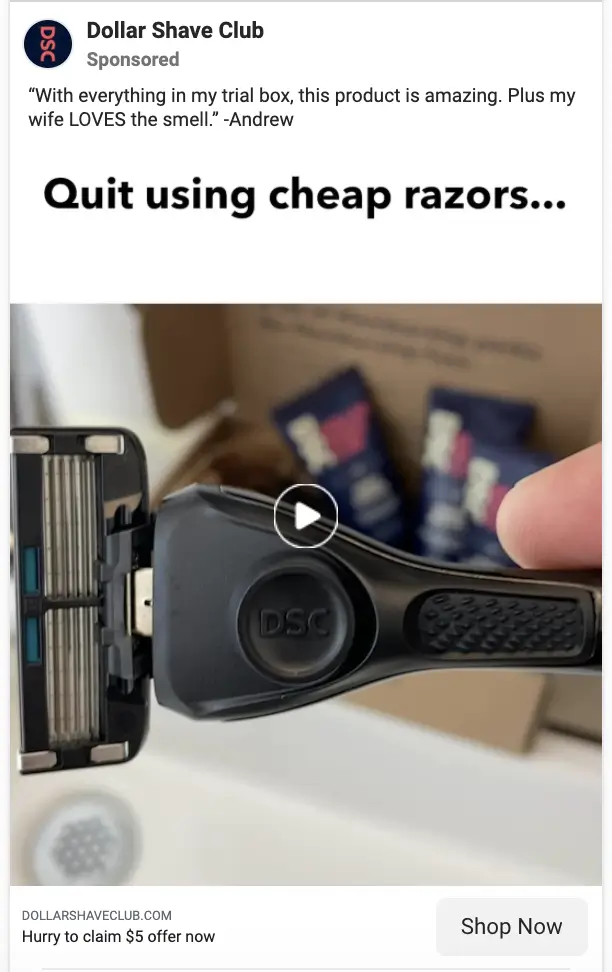When someone claims that organic social is no longer effective, ask if they’ve explored mixing it with paid social! In today’s ever-changing digital landscape, businesses should be adapt by combining various organic efforts with paid advertising methods rather than putting all their eggs in one basket. This calls for a hybrid strategy where brands navigate through different channels to maximize their impact.
Let’s explore how companies can merge paid with organic social to unlock social media success.
What is Organic Social & Its Benefits
Organic social media means posting on social networks for free, without paying to reach an audience. It’s all about building a connection with your followers. When you share an organic post, your followers see it in their feed. Others might see it too, through hashtags, location tags, mutual friends, or social media algorithms that suggest content based on interests.
Studies find that 73% of businesses prefer organic social as it’s effective at reaching and engaging audiences naturally.
- Let’s dive into why organic social media is great for businesses:
- It’s a free way to promote and sell, and you can start using it right away without a budget.
- Organic social media helps build trust with your audience because there’s no pressure; each follower decides whether to engage with your content.
- Subscribers trust the content they choose to see over ads because it’s tailored to their interests.
- You can form a loyal community around your brand with little cost and effort.
Remember, 90% of social media marketers believe that an active online community is essential to a successful social media strategy.
“From my years in marketing, one thing’s clear: online communities aren’t a choice; they’re a must. They’re what brands need to build real connections and keep growing strong.” – Oleksiy Kutsenko, the CMO at DDI Development
Organic social media promotion is a big deal for businesses looking to thrive now and in the future. They also get a loyal community as a bonus.
Example of Organic Social Media
Starbucks shines on social media by showcasing its baristas, the frontline employees who interact directly with customers. This humanizes the brand and sets Starbucks apart.
Moreover, Starbucks showcases its commitment to sustainability by encouraging eco-friendly practices, such as using fewer cups and bringing your own cup for coffee.
The brand also fosters its community by highlighting individuals who contribute to its sustainability efforts, emphasizing a sense of belonging and long-term viability.
However, there’s a catch. Algorithms keep changing, leaving brands relying on organic promotion at their mercy. There’s no guarantee that their content will reach interested subscribers. Valuable posts can get lost among the many others in the feed.
What about paid social? Is it a better option?
What is Paid Social & Its Benefits
The term “paid social” suggests paying for promotion. Brands or users pay to:
- Boost brand awareness
- Reach the right audience
- Increase sales
Paid social is an investment in platforms such as Facebook, Instagram, LinkedIn, X, YouTube, TikTok and others. Brands share content here with a targeted audience, i.e. those who you create content for would find it relevant. The concept of paid social may include paid ad campaigns such as Dynamic ads, Social Display etc. Other paid social tactics may include partnering with influencers who align with your brand to create user-generated content for you.
Different ad platforms have different payment methods, but the most popular ones include:
- Pay Per Click (PPC): Brands are charged for each click on an ad that directs users to a promoted page, site or content.
- Cost per mile/impression: Brands pay for every 1,000 impressions, regardless of whether subscribers engage with the content. This is better for awareness!
You can utilize paid social ads to increase brand awareness, drive website sales, or even generate more leads!
Let’s take a look at the key benefits of paid social for businesses:
- Unlike organic, paid social isn’t at the mercy of algorithms. It’s fully controllable and customizable based on your goals and budget.
- You can expand brand awareness beyond your current followers to reach a wider audience.
- Ads reach people who are interested in what you have to offer, resulting in higher conversion rates.
- You can deliver more personalized content and interactions with your brand by targeting audience demographics and behaviors.
Ultimately, the combination of broad reach and personalization increases brand awareness and attracts more subscribers and/or customers.
Main Difference Between Organic & Paid Social
Now that we’ve sorted out what organic and paid social are, let’s highlight their main difference:
Organic social doesn’t cost the company any money and builds a tight-knit community, creating brand advocates, but may not directly drive sales.
Paid social, on the other hand, reaches a much larger audience, increasing the chances of sales, but it does require a financial investment.
Even though paid advertising requires payment, it remains popular. Emarketer predicts a 13.5% growth in social media ad spending in the U.S. to $82.88 billion in 2024.
Both methods have their pros and cons for businesses. Our job is to combine the benefits of organic and paid social for better results.
So, how do we do it?
Creating a Hybrid Strategy
Organic social is tricky, but going all out on paid promotion isn’t wise either. So, what’s the solution? It’s about finding a balance – combining both organic and paid social methods.
5 Key Steps to Mix Organic and Paid Social
Now that we have all the information we need about paid and organic social, let’s get down to business.
1. Identify your winning content format
Begin with what’s working. Review your top-performing and viral posts to uncover the format that connects best with your audience. Assess metrics like engagement, conversion, and cost, while also considering elements such as visuals, calls to action, text content, reactions, and comments. You don’t have to promote every successful post but focus on boosting the most viral ones.
2. Evaluate your paid ads
In a hybrid strategy, you use ad budgets to boost your organic reach. Before moving forward, review how you’ve used your advertising budget in the past. Compare what you actually spent with what you planned to spend, and consider the results you achieved. This will help you determine if the budget was effective or if adjustments are needed.
Consider metrics such as impressions, price per thousand impressions, clicks, price per click, engagement, price per interaction, web conversions, and price per conversion. Also, compare results from different ad periods to identify improvements. You may check social media reports to track the performance of different posts with ads and see which one gets more engagement.
For a deeper understanding of how to optimize these metrics, consulting with a paid media agency can provide valuable insights and strategies tailored to your specific goals.
3. Make the most out of organic interactions
One valuable approach is retargeting, which involves setting up precise social media ads for ‘similar’ audiences. This could include contacts from your CRM system or email list, people who have engaged with your website, or those who have interacted with your content on social platforms. This way, your paid ads target people who have organically discovered your brand and turned loyal to you. Stick to this plan and you’ll have successful email campaigns and equally effective other interactions with your audience.
4. Take advantage of User-Generated Content (UGC)
The UGC isn’t just about promoting a brand on social media. In fact, 85% of consumers surveyed find it more influential than branded content. So what’s so great about this type of content? It’s about encouraging your loyal audience, which you’ve naturally grown, to create content related to your brand. Then you can distribute it through paid advertising campaigns.
When users speak highly of a product or seller, it’s very persuasive to potential clients. About 70% of consumers still trust other people’s opinions. So when subscribers create content recommending a product or brand, it becomes more meaningful to those who may be interested.
User-generated content is not about bombarding users with ads. It is simply inviting users to interact with the brand. This approach makes people feel valued and that they are part of something greater.
UGC example
Allbirds, known for their comfortable and eco-friendly sneakers, invited its subscribers and customers to share photos of themselves wearing Allbirds sneakers on social media using the hashtag #weareallbirds. The brand then features the best photos on its page.
Search that hashtag on Instagram and you’ll see the results: subscribers loved the idea.
5. Stay consistent, measure everything
To successfully combine organic and paid social media promotion, follow these steps:
- Maintain a consistent social media presence by scheduling both paid advertising and organic posts regularly.
- Consider the time and expertise required to create different types of posts to ensure continuous engagement with your audience.
- Diversify your content and post formats to keep your audience interested and engaged.
- Monitor and analyze the effectiveness of both organic and paid posts using relevant metrics.
- Make necessary adjustments to your content strategy based on the insights gathered from your analysis.
At the end of the day, it’s important to stay proactive and responsive to ensure that your marketing efforts are effective and get you the results you want.
Example of a Hybrid Social Strategy
Dollar Shave Club shows us how it’s done. They use paid advertising (labeled as Sponsored) on social media, but back up their credibility with social proof – customer reviews:
Another interesting initiative is the #MenGetReal campaign, where the brand partners with real people. It’s more than just posting photos with the hashtag; these posts clearly show that the influencers are real partners with the brand. Perhaps there is a paid partnership here, and at the same time – there is an organic increase in brand awareness through an ad campaign supported by the #MenGetReal hashtag:
To Sum It Up
As you’ve probably noticed, mixing organic and paid social media tactics is key for enhancing your brand’s online impact. By weaving these approaches together, you can interact genuinely with your customers, extend your reach, and ultimately boost sales.
Stay consistent with your social media efforts, analyze your results, and be flexible with your approach. This will help you harness the full potential of social media and achieve steady business growth.
So, why not give hybrid social strategies a try?








